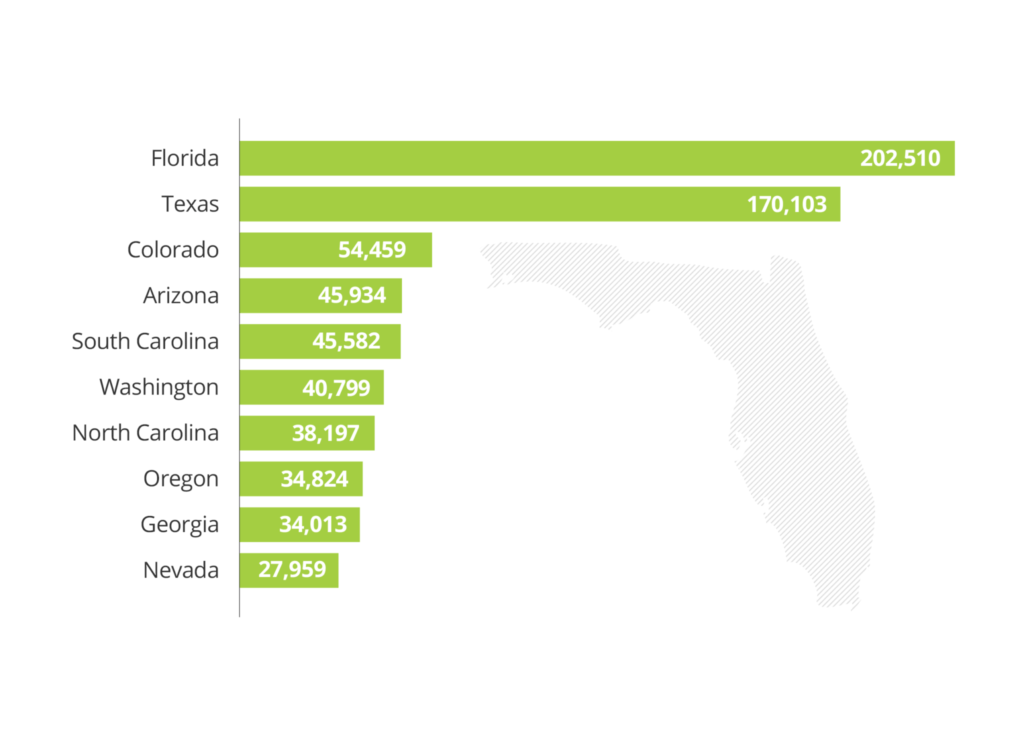- Migration patterns in the U.S. have changed, and people are no longer moving out west to large costal cities.
- Instead, people are moving from California and New York for more affordable options in Florida, Texas, the Carolinas and Oregon -- to name a few.
- New Census Bureau data shows a renewed migration from the Snow Belt to the Sun Belt.
For more than a century, American housing migration patterns followed a familiar trajectory: U.S. homebuyers headed predominantly west to cities such as Los Angeles, San Francisco, San Diego and Seattle, where their families and friends had settled or jobs awaited them.
Once there, for a generation or two, they stayed put and laid roots in the communities where they settled. Eventually, their children and grandchildren moved to the suburbs. And the cycle repeated itself generation after generation.
One of the greatest examples of this westward migration occurred during the Great Depression, when a devastating drought known as the Dust Bowl forced hundreds of thousands “Okies” to flee Oklahoma, Texas, Kansas, Georgia and Tennessee and migrate to California.
In 1940, Woody Guthrie captured the essence of that great American 20th century western diaspora in his classic folk song “migration patterns.” In the song, Guthrie sings:
“California is a garden of Eden
A paradise to live in or see;
But believe it or not
You won’t find it so hot
If you ain’t got the do re mi.”
Guthrie was warning Okies about how expensive it was to live in Depression-era California without the “do re mi” (money). Guthrie, who lived in Los Angeles, had witnessed the economic hardship that many migrants were experiencing when they arrived in California.
This 20th-century movement west, which has dominated American demographic patterns for decades, might now be reversing itself in the 21st century as rising housing costs, stagnant job creation, restrictive land-use laws and no-tax states, pull Californians, Midwesterners and Northeasterners eastward and southward to less costly regions and more business-friendly states in the Sun Belt.
Where are housing refugees moving to?
According to a recent migration patterns report, Americans are increasingly moving eastward and southward, fleeing large expensive coastal states such as California and New York, and heading to more affordable states, including Florida, Texas and the Carolinas where housing costs are more affordable, the weather is temperate and taxes are low.
Although Oregon was the leading moving destination, five states east of the Rocky Mountains — South Carolina, North Carolina, Florida, Vermont and Texas — topped the in-bound migration states.
On the flip side, the leading outbound states included New Jersey, New York, Illinois, Connecticut, Ohio, Kansas and Massachusetts. Many of these states have been experiencing massive domestic outflows because of high housing costs, lack of job opportunities and high state and local tax rates.

According to William H. Frey, a demographer and senior fellow at migration patterns in Washington, D.C., migration patterns from states in the Snow Belt (Northeast and Midwest) to formerly booming states in the Sun Belt, such as Arizona, Florida and Nevada, began to slow as soon as the Great Recession hit and continued to shrink even into 2010.
But new Census Bureau data shows a renewed Snow Belt-to-Sun Belt migration pattern, according to Frey.
Renewed Sun Belt migration
“The sizeable migration shifts from the states in the Snow Belt (migration patterns) region to the Sun Belt (migration patterns) region over the 2000 to 2006 period tapered off noticeably during the mortgage meltdown and recession years,” wrote Frey in recent migration patterns citing new Census bureau data.
“Specifically, previously fast-growing states like Nevada, Florida and Arizona experienced sharp slowdowns in migration and in the case of the former two states, migration patterns for some of these years.”
Frey said that the Sun Belt-to-Snow Belt housing migration has resumed again.

“The eastward migration of Californians has been going on for a long time, since the 1990s,” Frey said. “California acts like a northern state, with its high housing costs.”
Nowhere is the Snow Belt-to-Sun Belt housing migration shift more apparent than the Sunshine State. For the first time in almost a decade, Florida added more people than California between July 2014 and July 2015, according to the migration patterns.
Florida gained 365,703 people, leapfrogging over New York to become the nation’s third most populous state, after California and Texas. Californians are moving to Arizona, Oregon and Washington.
New Yorkers are flocking to Florida, Georgia and North Carolina. And everybody seems to be moving to Texas. The Census Bureau said that southern and western states had driven much of the population growth nationwide.
Since 2014, according to the Census Bureau, over 1.4 million people have moved to the Sun Belt mostly from the Northeast and Midwest. The 10 states that added the most people from elsewhere in the U.S. since 2010 are: Texas, Florida, California, Georgia, Washington, North Carolina, Colorado, Arizona, South Carolina and Oregon.
Housing refugees
These Snow Belt-to-Sun Belt migrants are America’s “housing refugees,” middle-class workers displaced from states such as New York, Illinois, California, New Jersey and Maryland because of high housing prices, diminishing jobs and high taxes.
Sunshine and warm weather have helped the Sun Belt ascendancy. But the key forces driving people to the Sun Belt are largely economic — notably lower housing prices, job creation and lower taxes.
Consider self-proclaimed housing refugee Peter G. Miller. After five decades of living in the D.C. area, he and his wife decided to move to Florida. In 2015, the Millers packed their bags and left Silver Springs, Maryland and headed to Pensacola, Florida, seeking a smaller community, warmer weather, less taxes and flood-free zones.
Read the full story in the Housing News Report.
Octavio Nuiry is the managing editor of RealtyTrac.








